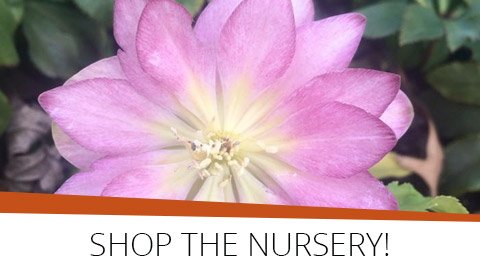Before you dig, call 811 to locate your utilities!
Ready?
To begin, outline the planting hole to a size 2 to 3 times the diameter of the root ball. As you dig, separate the top soil from the subsoil so that you can put it back later in the same way it came out. Break up the soil clumps by turning them over and over with your spade and mincing the soil as finely as possible. This will eliminate air pockets, prevent excessive settling, and make the plant very solid in the hole after it has been planted.
Deeper is not better
The goal with any transplanting is for the plant to end up at the same grade as it was in the container, or a little higher. If the hole is too deep, the plant will settle below grade, creating drainage and aeration problems right from the start. This is very important when planting in poorly-drained clay soils. To make sure the hole’s depth is correct, measure the root ball. Then lay a shovel or board across the hole and measure to the bottom of the hole, matching the depth to that of the root ball or a little shallower. (Measuring ensures a proper fit without lifting the plant in and out of the hole.) When we plant here at the nursery we try to end up with the root ball sitting 1 to 2 inches above grade. This almost guarantees the plant won’t settle too low. After the hole is dug to the correct breadth and depth, take a garden fork or cultivator and scratch the inside of the hole so the surfaces aren’t glazed. A smooth, compacted wall is difficult for new roots to penetrate, especially in clay soils. Roughing up the hole will allow the roots to grow and establish more quickly.
Prepare the Roots
You should never take a plant out of the pot and just stick it in the ground. Have you ever pulled up a plant that died, only to find the roots had never left the original root ball? In a container-grown plant, it is only natural that the roots will start circling the container; they will tend to continue to circle and never find their way into your ground if you don’t untangle them before planting. You will need to unwrap the roots, starting at the bottom and working your way up and around the sides. The roots should be gently loosened and spread so they will grow into the new soil. A few roots may tear or break off in the process, but it’s similar to pruning the top of the plant in that new growth will form and branch out. This is a good thing! Don’t worry about losing some potting soil from around the roots, as it is important for the roots to contact the new soil in which they will be growing. Your plant will establish itself much sooner and require less watering by using this planting method. Failure to prep the roots may prevent the plant from growing successfully.
Amend the Soil
Many soils, particularly clay, can be improved by adding organic materials such as sphagnum peat moss and composted manure. When we plant, we mix equal parts of bagged Michigan peat, compost, Canadian sphagnum peat, and top soil with the dirt we dug out of the hole. This mixture will be used to fill in around the plant.
It’s Time to Plant!
After the plant is set in the hole it can be turned to position it, if desired, and the roots should be spread out into the hole. Double check that the planting depth is correct; if you’ve misgauged, it’s much easier to correct it at this stage than after the hole is filled! Begin putting your soil mixture into the hole, packing it down around the root ball. When the hole is half filled, check to make sure your plant is straight, then water it. Finish filling the hole, mounding the soil up to the top of the root ball. Soak the whole area well.
The Big Finish
For many trees, a staking system is important to help provide stability and straight growth while becoming established. Fertilize your plant with a time-release fertilizer such as the one we use at the nursery. This will help offset any transplant shock, jump-start new root growth, and give your plant a gentle, steady source of nutrients.



Share